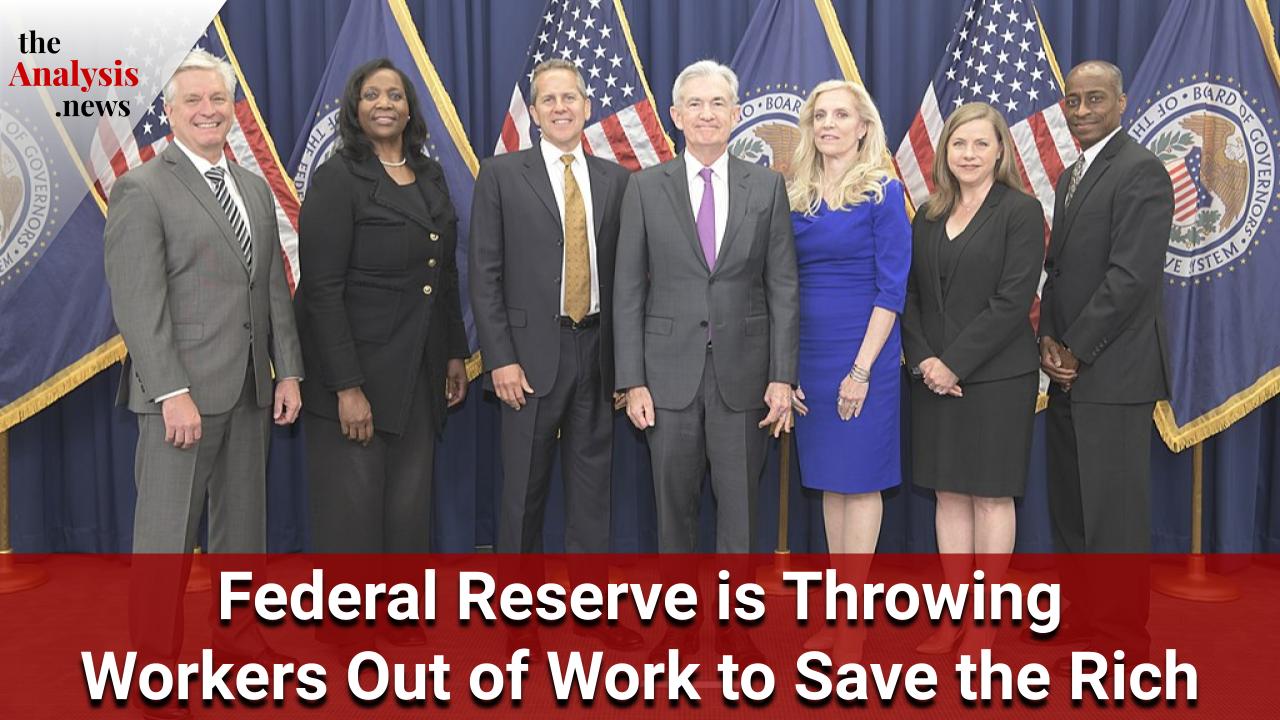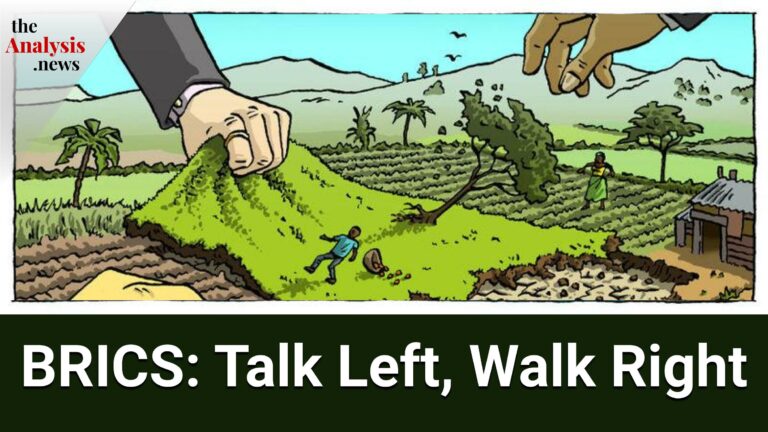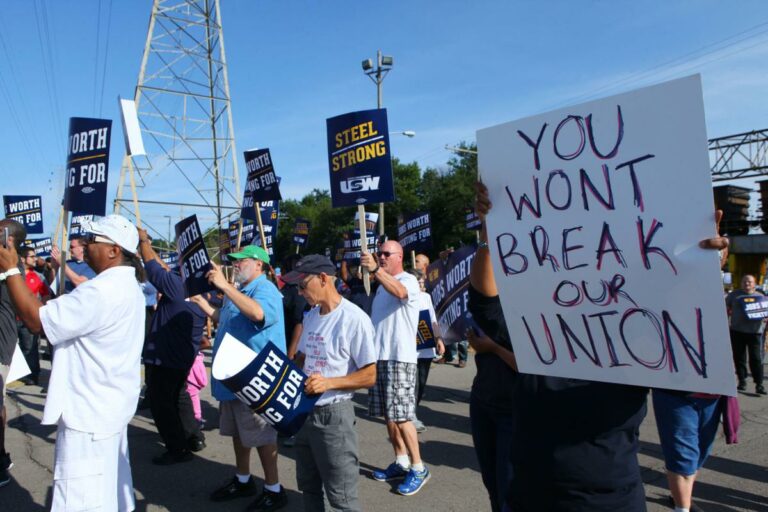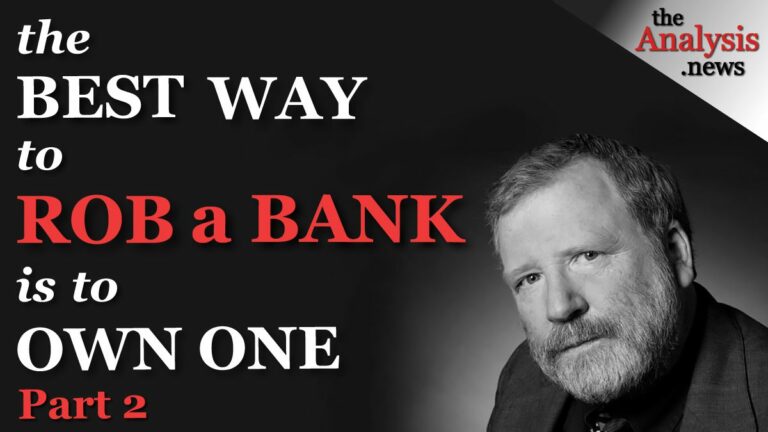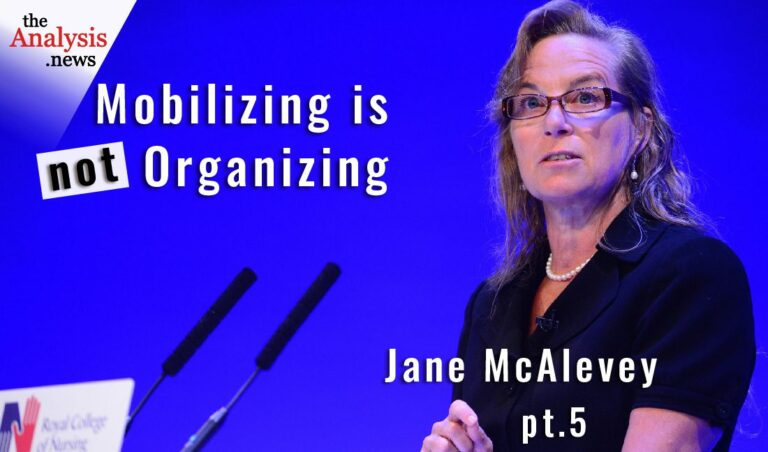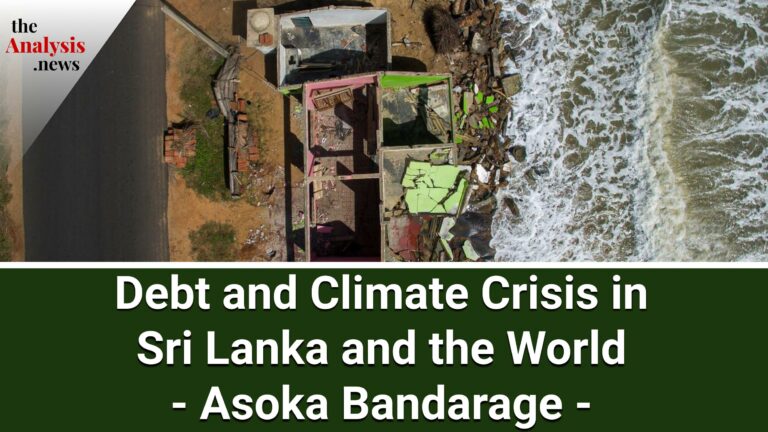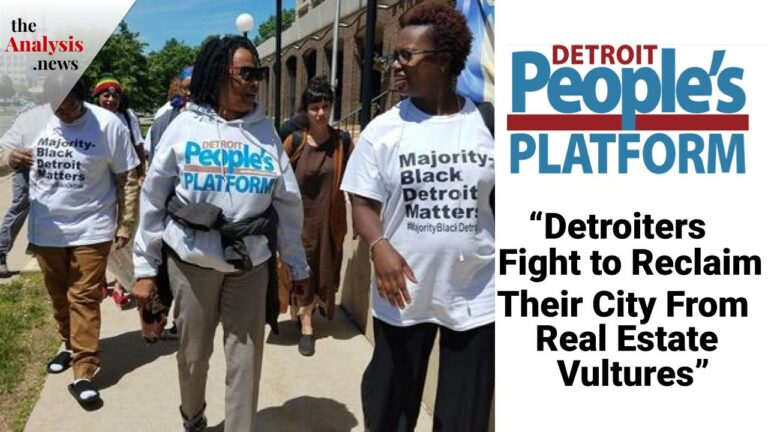Federal Reserve is Throwing Workers Out of Work to Save the Rich
Members of the Federal Reserve: Chris Waller, Lisa Cook, Michael Barr, Jay Powell, Lael Brainard, Miki Bowman, and Philip Jefferson.
Economists Gerald Epstein and Aaron Medlin’s data shows the paradox of ignoring employment and choosing to throw workers out of work has persisted over time at the Federal Reserve.
Sharmini Peries
This is theAnalysis, and I’m Sharmini Peries. In just a few minutes, I will be speaking with an economics professor, Gerald Epstein, about how the Federal Reserve’s inflation reduction policy is targeted to protect the rich and the wealthy and not the workers, not the unemployed, or the ordinary person that is feeling the real brunt of this inflationary economic crisis we are in.
Welcome back. Professor Gerald Epstein is the co-director of the Political Economy Research Institute at the University of Massachusetts, Amherst. He is the author of The Political Economy of Central Banking: Contested Control, and the Power of Finance. And also, What’s Wrong with Modern Money Theory? A Policy Critique. These are only two of the many books he’s published.
But in December, Professor Epstein convened a conference on inflation with some of the leading economic thinkers on the topic. At this conference, Professor Epstein himself presented a paper titled Federal Reserve Anti-Inflation Policy: Wealth Protection for the 1 %?–and that is a question– which you can find on the PERI website, as well as a small summary of it in the American Prospect. We’ll provide a link for it below. Jerry, welcome.
Gerald Epstein
Thank you so much for having me, Sharmini.
Sharmini Peries
Jerry, it must be really frustrating for you, someone like you who has been following this issue in terms of money theory, inflation, monetary policy, and finance for so long. And you have the research, the analysis, and you understand the effects of such policy, so tell us why this is yet again being implemented, although we have plenty of evidence that this is not the best route to go. So put this in the deserved context.
Gerald Epstein
So the Federal Reserve is seen as the institution in the United States and like other central banks in other countries whose job is to control inflation. But in fact, the Federal Reserve, our central bank, has a dual mandate given to it by Congress. One is to keep prices stable; that’s the inflation control. But a second is to pursue a policy to maintain high employment. But it turns out that whenever these two are perceived to be in some kind of conflict, the Federal Reserve always chooses to fight inflation and to ignore its congressional-given mandate to maintain high employment. It fights inflation by raising interest rates, and that throws people out of work, so it just ignores the employment part. The question that my colleague, my graduate student, Aaron Medlin, and I asked is, “Why? Why does the Fed cavalierly ignore this employment mandate to fight inflation?”
Sharmini Peries
We’ll get back to the issue of why it ignores employment. But your paper provides evidence that shows that this policy serves to protect the 1% and perhaps the 10%, the top 10%. In other words, it is aimed to restore some of the lost wealth that is experienced during this COVID or pandemic slowdown, which is often blamed on supply chain issues and so on. So tell us how your paper comes to this conclusion.
Gerald Epstein
What we do is try to explain this paradox of ignoring employment and choosing to throw workers out of work by looking historically over time at how the Federal Reserve has responded both in periods of high inflation and in periods of low inflation. And what it does is the paper looks at the impact of Federal Reserve policy on wealth distribution. The top 1%, the top 10%, and the bottom 50%. We look at the impact of inflation on wealth distribution.
Now, how does this work? Well, the wealthy tend to be people who own financial assets, and the bottom 50% are people who tend to be in debt. They’ve borrowed money. We know from economic theory that the wealthy, the bankers, the creditors, and the people who have lots of financial assets, they don’t like unexpected inflation because that erodes the real value of their wealth. Whereas people who are borrowers, like students and others, they don’t tend not to mind inflation quite as much because when they have to pay back their loans, it’s in money that’s worth less.
What we did was we looked at the impact of inflation on the wealth of the wealthy and the bottom 50%, both with and without an increase in interest rates. What we found is that when the Federal Reserve does not increase interest rates, the wealth of the top 1% goes down by about 30%. But when the Fed raises interest rates considerably, as it has been doing, the wealth of the top 1% only goes down by about 15%. So, in other words, this big increase in interest rates is a wealth protection device for the wealthy. On the other hand, it has either no impact or it actually hurts the wealth of the bottom 50%. So that’s how this process works. We can show historically how in periods of high inflation, this has been the policy and the impact on the wealthy from the Federal Reserve.
Sharmini Peries
How does it protect the wealthy and their wealth?
Gerald Epstein
Well, in fact, it has two contradictory effects. On the one hand, when the Federal Reserve raises interest rates, that tends to lower the value of, in nominal terms or in money terms, the value of wealthy people’s stocks, bonds, and so forth. We saw how the stock market crashed when the Federal Reserve raised interest rates. So that actually hurts the wealth of the wealthy. On the other hand, when the Federal Reserve raises interest rates and throws people out of work, eventually, it tends to lower inflation, which improves the real wealth, inflation-adjusted wealth of the wealthy.
So you have these two effects, the decline in the nominal value of rich people’s wealth on the one hand but the increase in the inflation-adjusted value of rich people’s wealth on the other. The net effect depends on the timing and the size of these two effects. What we found in this most recent inflation, for example, is that the net effect of these two things was to increase or protect the wealth of the wealthy.
Now, this difference, these two contradictory effects, you see sometimes plays out in the debates that the wealthy have over Federal Reserve policy. We can see now that sometimes some of the wealthy people are saying, “enough, enough. The Fed has stopped inflation enough. Let’s lower interest rates and get our stock market values back up again.” But other members of the top 1% say, “no, no. We need to keep raising interest rates to fight inflation.” And this depends on their perception of these two contradictory effects. But the point is, none of them are concerned about what’s happening to the workers or the bottom 50%. They’re just worried about their own portfolios.
Sharmini Peries
What are the effects, Jerry, of raising the interest rates on the unemployed, for example?
Gerald Epstein
Well, typically, when the Federal Reserve raises interest rates, certainly by as much as it has been doing, three, four, four and a half percentage points, it makes it harder to borrow money to buy a house, for consumers to borrow money on their credit cards, for businesses to borrow money to expand or even keep their businesses going. What tends to happen, and what the Fed is actually hoping for, is that these businesses will lay off workers. They’ll throw more people into the reserve army of the unemployed. So this policy tends to hurt workers. It tends to hurt small businesses while, as we found, protecting the wealth of the top 1%.
Sharmini Peries
Now, is anyone calling out the Fed on this that they have a dual mandate here to keep employment high as well? Or are those voices small and unheard?
Gerald Epstein
Well, you started at the beginning about how frustrating this is. And this is one of the places where it’s so frustrating because very few of the mainstream voices, very few, if any, of the mainstream press, are pointing out this dual mandate issue. They just accept this idea that somehow when inflation is higher than they like, that somehow it’s the workers who have to sacrifice. It’s the employed that have to sacrifice. They treat this like it’s a known fact. It’s a force of nature, and there’s nothing that can be done about it. Of course, people, unions, people on the Left, and others who came to our conference do point this out quite clearly. But the business press, even the mainstream press in the New York Times and elsewhere, completely ignore this and say, “well, it’s just the price that we have to pay.” Well, they don’t have to pay it. It’s the workers that are paying it.
Sharmini Peries
One of the other dominant narratives out there is we are expecting a recession. We are expecting a recession. We are expecting a recession. It’s preparing the public for that.
Gerald Epstein
Virtually every recession we’ve had in the United States in the last 50 years has been preceded by increases in Federal Reserve interest rates, and therefore, one can probably surmise it’s probably caused by that. So again, it seemed like, well, it’s a price we have to pay to keep inflation low. I think you interviewed Bob Pollin, who pointed out that there’s no reason why we have to reach this 2% inflation target. That makes no sense. But the business press and most observers just accept this, reaching a 2% inflation target no matter what the cost in terms of unemployment, as given. There are better ways to deal with this. There are many better ways to deal with this.
Sharmini Peries
What are those?
Gerald Epstein
Well, first of all, you have to attack the problems that are causing the inflation. As some people came to our conference, Josh Bivens and others pointed out, there are three main causes. One is the profit push, the monopoly power of companies to raise prices and enhance their profits. That’s one thing that’s keeping the inflation going. The second is the supply chain problems that resulted from the pandemic and the war in Ukraine. And third is just standard difficulties that our economy is having and adjusting to this chaotic experience of the last two and a half years from COVID and then the crisis. So these are mostly supply-side problems. The solution is to deal with them directly.
On the one hand, it’s to subsidize the consumption of workers so that they’re not the ones who are bearing the burden of inflation. Workers and unemployed, people in the care sector, as Nancy Folbre pointed out at the conference, to subsidize those, to put profit taxes on the companies that are profiting from this inflation and redistributing that to people who are being hurt by it, and then to make some very targeted price controls on those sectors that are price gouging to help control the inflation.
Finally, I think, as Bob Polin was pointing out, don’t be obsessed with this 2% inflation target. We already have an inflation rate in the United States that’s coming down to roughly around 3.5%, 4%. At a certain point, it’s not worth the cost in terms of high unemployment, hurting workers to reach an arbitrary target of 2%.
Sharmini Peries
Jerry, talking about hurting workers, one booming narrative out there is that inflation was… all this inflation was caused by the stimulus package provided to help during the COVID and pandemic crisis. They claim that there’s too much money in the economy, and that’s why they have to raise the interest rates to get it under control. What is your response to that?
Gerald Epstein
Well, it is true that if we hadn’t had the expansionary package around COVID, we probably would have had a deflation, we would have had a depression. Would that have been better? The narrative should be, yes, that’s what saved our economy from a terrible depression and terrible deflation. So that was the right policy. Number two, there probably are some areas in the economy where there’s excess spending, but that has much less to do, I think, with the expansionary policy from the COVID years than it has to do with the huge boom in the wealth of the rich people who are the top 1%, the top 10% in the period prior who were able to spend that money on goods and services. So I don’t think the narrative holds water, but it’s very dangerous because now it’s being used in the U.S. by the Republicans to say, “well, we’ve got to cut spending, we’ve got to cut the deficit, we’re not going to raise the debt ceiling because that’s what’s causing inflation.” It’s a very dangerous narrative, and it’s wrong.
Sharmini Peries
If you’re the working poor in this country and trying to make ends meet, not only in this country, the world over at the moment, because of the spillover effects it’s having in all parts of the world, and you just can’t pay for the things you use to be able to pay for, provide for your family, go out for a celebration dinner, and so forth. What does your research findings say to them in terms of a message? What do they need to do?
Gerald Epstein
Well, it’s not what they need to do; it’s what the government needs to do to help people in this situation. For example, in the United States, as part of the anti-COVID package, we had a big increase in the earned income tax credit, and that helps families with small children, poor families with small children, and they let that lapse. That should be made permanent, and it should be increased. There should be more subsidies for housing and for rent for people. Again, there was a temporary moratorium during COVID. On that, that should be extended. So there need to be subsidies for the very poorest through the tax system rather than massive tax subsidies for the rich, which the Republicans and some Democrats now want to increase. So the government needs to make the cost of living more affordable for the poor and the working class and not make it harder for them by throwing them out of work.
Sharmini Peries
One final question I have for you, Jerry. President Biden will make a State of the Union address, and I’m sure he will be addressing the inflation issue as we’ve just discussed. What do you expect from the administration at this point?
Gerald Epstein
Well, he’ll probably say that they’ve made progress. They’re continuing to make progress. He’ll back the Federal Reserve, saying it’s doing the right thing and we just need to give it some more time, and it’s working. Which I think is exactly the wrong message. He should be urging the Federal Reserve to loosen up and urging the government to make some of these other kinds of policies, these subsidies, profit taxes, and so forth, that I talked about before.
Sharmini Peries
Alright, Jerry, we’ll come back to you, perhaps, after the State of the Union address. I thank you so much for joining me today.
Gerald Epstein
Thank you very much.
Sharmini Peries
Thank you for joining us on theAnalysis.
Sharmini Peries
Esto es The Analysis, y yo soy Sharmini Peries.
En solo unos minutos, estaré hablando con el profesor de economía Gerald Epstein sobre cómo la política de reducción de la inflación de la Reserva Federal está dirigida a proteger a los ricos y privilegiados y no a los trabajadores, los desempleados o las personas normales, que son los que más están sintiendo los efectos de esta crisis económica inflacionaria en la que estamos.
Bienvenido de nuevo.
El profesor Gerald Epstein es codirector del Instituto de Investigación de Economía Política de la Universidad de Massachusetts, Amherst. Es autor de The Political Economy of Central Banking: Contested Control and the Power of Finance, y también de What’s Wrong with Modern Money Theory? A Policy Critique. Estos son solo dos de los muchos libros que ha publicado.
Pero en diciembre, el profesor Epstein organizó una conferencia sobre inflación con algunos de los principales economistas. En esta conferencia, el propio profesor Epstein presentó un documento titulado Federal Reserve Anti-Inflation Policy: Wealth Protection for the 1%? —y es una pregunta—, que puede leer en el sitio web de PERI, así como un pequeño resumen del mismo en el American Prospect. Dejaremos un enlace abajo.
Jerry, bienvenido.
Gerald Epstein
Muchas gracias por invitarme, Sharmini.
Sharmini Peries
Jerry, debe de ser muy frustrante para ti, alguien que ha estado siguiendo este tema sobre la teoría del dinero, inflación, política monetaria, finanzas, durante tanto tiempo, y que tiene los estudios, el análisis, y comprende los efectos de dicha política. Dinos por qué se está implementando una vez más, a pesar de que tenemos muchas pruebas de que este no es el mejor camino a seguir. Pon esto en el contexto adecuado.
Gerald Epstein
La Reserva Federal está considerada como la institución en los Estados Unidos, al igual que otros bancos centrales en otros países, cuyo trabajo es controlar la inflación. Pero, de hecho, la Reserva Federal, nuestro banco central, tiene un doble mandato otorgado por el Congreso. Uno es mantener los precios estables; eso es el control de la inflación. El segundo es seguir una política para mantener un alto nivel de empleo.
Pero resulta que cada vez que perciben que estos dos están de alguna manera en conflicto, la Reserva Federal siempre opta por luchar contra la inflación y hacer a un lado su mandato otorgado por el Congreso de mantener un alto nivel de empleo. Combate la inflación elevando los tipos de interés, y eso hace que mucha gente pierda su trabajo, así que no cumple la parte del empleo.
La pregunta que mi colega… mi estudiante de posgrado Aaron Medlin y yo hicimos es: ¿Por qué? ¿Por qué la Fed incumple este mandato del empleo para combatir la inflación?
Sharmini Peries
Volveremos al tema de por qué no considera el empleo.
Tu artículo proporciona evidencia de que esta política sirve para proteger al 1 % más rico, y quizá el 10 % más rico. En otras palabras, su objetivo es restaurar parte de la riqueza que se perdió durante esta desaceleración del COVID, o la pandemia, que a menudo se atribuye a problemas de la cadena de suministro, etc. Dinos cómo llegas a esta conclusión en tu artículo.
Gerald Epstein
Lo que hacemos es tratar de explicar esta paradoja de no considerar el empleo y optar por dejar a muchos trabajadores sin trabajo observando históricamente a lo largo del tiempo cómo ha respondido la Reserva Federal tanto en periodos de alta inflación como en periodos de baja inflación.
El documento analiza el impacto de la política de la Reserva Federal en la distribución de la riqueza. El 1 % más rico, el 10 % más rico y el 50 % más pobre. Analizamos el impacto de la inflación en la distribución de la riqueza. Ahora, ¿cómo funciona esto? Bueno, los ricos tienden a ser personas que poseen activos financieros, y el 50 % más pobre son personas que tienden a estar endeudadas, que han pedido dinero prestado. Sabemos por la teoría económica que a los ricos, los banqueros, los acreedores, las personas que tienen muchos activos financieros, no les gusta la inflación inesperada porque erosiona el valor real de su riqueza. A las personas que son prestatarios, como estudiantes y otros, normalmente no les importa tanto la inflación porque cuando tienen que pagar sus préstamos, es en dinero que vale menos.
Lo que hicimos fue observar el impacto de la inflación en la riqueza de los más ricos y el 50 % más pobre, con y sin aumento de los tipos de interés. Lo que encontramos es que cuando la Reserva Federal no aumenta los tipos de interés, la riqueza del 1 % más rico disminuye en aproximadamente un 30 %, pero cuando la Fed aumenta considerablemente los tipos de interés, como ha estado haciendo, la riqueza del 1 % más rico solo se reduce en un 15 %. En otras palabras, este gran aumento en los tipos de interés es un dispositivo de protección de la riqueza de los ricos.
Por otro lado, no tiene ningún impacto o perjudica la riqueza del 50 % más pobre. Así es como funciona este proceso. Podemos mostrar históricamente que, en periodos de alta inflación, este ha sido el efecto para los ricos de la política de la Reserva Federal.
Sharmini Peries
¿Cómo protege a los ricos y su riqueza?
Gerald Epstein
Bueno, de hecho, tiene dos efectos contradictorios. Por un lado, cuando la Reserva Federal sube los tipos de interés, eso tiende a disminuir, en términos nominales o en términos monetarios, el valor de las acciones, bonos, etc., de los ricos. Vimos cómo se derrumbó el mercado de valores cuando la Reserva Federal subió los tipos de interés. Entonces, eso daña la riqueza de los ricos. Por otro lado, cuando la Reserva Federal sube los tipos de interés y muchas personas pierden su trabajo, tiende a bajar la inflación, lo cual aumenta la riqueza real, la riqueza ajustada a la inflación, de los ricos.
Así que vemos estos dos efectos, la disminución del valor nominal de la riqueza de los ricos por un lado, y el aumento en el valor ajustado a la inflación de la riqueza de los ricos por el otro. El efecto neto depende del momento y la magnitud de estos dos efectos.
Lo que encontramos en esta inflación más reciente, por ejemplo, es que el efecto neto de estas dos cosas fue aumentar o proteger la riqueza de los ricos. Ahora bien, esta diferencia, estos dos efectos contradictorios… A veces vemos esto en los debates que los ricos hacen sobre la política de la Reserva Federal. Podemos ver ahora que algunas personas ricas dicen: “Basta, basta. La Fed ha detenido bastante la inflación, bajemos los tipos de interés para que nuestros valores bursátiles vuelvan a subir”. Pero otros en el 1 % más rico dicen: “No, no, tenemos que seguir subiendo los tipos de interés para combatir la inflación”. Y esto depende de su percepción de estos dos efectos contradictorios. Pero lo que quiero decir es que a ninguno le preocupa lo que les está pasando a los trabajadores o al 50 % más pobre. Solo les preocupan sus carteras de inversión.
Sharmini Peries
¿Cuáles son los efectos para los desempleados, por ejemplo, de subir los tipos de interés?
Gerald Epstein
Bueno, por lo general, cuando la Reserva Federal aumenta los tipos de interés, ciertamente cuando lo hace tanto como ahora, tres, cuatro, cuatro y medio puntos porcentuales, hace que sea más difícil para la gente obtener un crédito para comprar una casa, para los consumidores comprar a crédito con sus tarjetas de crédito, para las empresas obtener créditos para expandir o incluso mantener sus negocios en operación. Lo que tiende a suceder, y lo que la Fed realmente espera, es que estas empresas van a despedir trabajadores. Pondrán a más gente en el ejército reservista de los desempleados. Así que esta política tiende a perjudicar a los trabajadores. Tiende a perjudicar a las pequeñas empresas, mientras que, según nuestra investigación, protegen la riqueza del 1 % más rico.
Sharmini Peries
¿Alguien está denunciando lo que hace la Reserva Federal, que tienen un doble mandato de mantener el empleo alto también? ¿O son esas voces pequeñas e inaudibles?
Gerald Epstein
Bueno, has hablado de lo frustrante que es esto. Y este es uno de los aspectos en que es frustrante porque muy pocas de las voces más consagradas y muy pocos, si acaso alguno, de los principales medios de comunicación, están señalando este tema del doble mandato. Simplemente aceptan esta idea de que, de alguna manera, cuando la inflación es más alta de lo que les gustaría, de alguna manera son los trabajadores los que tienen que sacrificarse. Son los empleados los que tienen que sacrificarse. Tratan esto como si fuera un hecho conocido, una fuerza de la naturaleza, y no se puede hacer nada al respecto. Por supuesto, la gente, los sindicatos, la gente de izquierda, y otros que asistieron a nuestra conferencia lo señalan claramente. Pero la prensa de negocios, incluso la prensa dominante, el New York Times y otros lugares, lo obvian por completo y dicen: “Bueno, es simplemente el precio que tenemos que pagar”. Bueno, ellos no tienen que pagarlo. Son los trabajadores los que lo están pagando.
Sharmini Peries
Otra tesis dominante es: Esperamos una recesión. Esperamos una recesión. Esperamos una recesión. Están preparando al público para eso.
Gerald Epstein
Prácticamente todas las recesiones que hemos tenido en Estados Unidos en los últimos 50 años han venido precedidas por aumentos en los tipos de interés de la Reserva Federal y, por lo tanto, podría suponerse que probablemente sean consecuencia de ello. De nuevo, parecía que, bueno, es un precio que tenemos que pagar para mantener baja la inflación.
Creo que entrevistaste a Bob Pollin, quien señaló que no hay razón para que debamos alcanzar esta meta de inflación del 2 %. No tiene sentido. Pero la prensa económica y la mayoría de los observadores simplemente aceptan sin cuestionarlo que hay que alcanzar una meta de inflación del 2 % sin importar el coste en términos de desempleo. Hay maneras mejores de resolver esto. Hay muchas maneras mejores de resolver esto.
Sharmini Peries
¿Cuáles son?
Gerald Epstein
Bueno, en primer lugar, hay que atacar los problemas que están causando la inflación. Algunas personas que asistieron a nuestra conferencia, Josh Bivens y otros, señalaron que hay tres causas principales. Una es la estrategia de aumentar las ganancias, el poder de las empresas que tienen un monopolio para subir los precios y aumentar sus ganancias. Eso es algo que sigue alimentando la inflación. La segunda son los problemas de la cadena de suministro que resultaron de la pandemia y la guerra en Ucrania. Y la tercera son las dificultades estándar que nuestra economía está teniendo para adaptarse a esta experiencia caótica de los últimos dos años y medio del COVID y luego la crisis.
Así que estos son en su mayoría problemas del lado de la oferta. La solución es tratar de resolverlos directamente. Por un lado, subsidiar el consumo de los trabajadores para que no sean ellos los que soporten el peso de la inflación. Ofrecer prestaciones a trabajadores y desempleados, personas del sector del cuidado, como señaló Nancy Folbre en la conferencia, gravar las ganancias de las empresas que se benefician de esta inflación, redistribuir eso a las personas que están sufriendo las consecuencias y luego aplicar algunos controles de precios muy específicos en aquellos sectores que están aumentando los precios para ayudar a controlar la inflación.
Finalmente, como apuntaba Bob Pollin, no deberían obsesionarse con este objetivo de una tasa de inflación del 2 %. Ya tenemos una tasa de inflación en los Estados Unidos que está bajando a alrededor del 3,5 % o el 4 %. Llega un momento en que no vale la pena el coste en términos de alto desempleo y perjudicar a los trabajadores para alcanzar un objetivo arbitrario del 2 %.
Sharmini Peries
Jerry, hablando de perjudicar a los trabajadores, una tesis prevalente es que la inflación fue… toda esta inflación fue causada por el paquete de estímulo dirigido a ayudar durante la crisis del COVID y la pandemia. Afirman que hay demasiado dinero en la economía y por eso tienen que subir los tipos de interés para controlarlo. ¿Cuál es tu respuesta a eso?
Gerald Epstein
Bueno, es cierto que si no hubiéramos tenido el paquete expansivo durante el COVID, probablemente habríamos tenido una deflación, habríamos tenido una depresión. ¿Habría sido mejor? La historia debería ser: sí, eso es lo que salvó nuestra economía de una terrible depresión y una terrible deflación.
Así que esa fue la política acertada. En segundo lugar, seguramente existen áreas de la economía donde hay un gasto excesivo, pero eso tiene mucho menos que ver, creo, con la política expansiva de los años del COVID que con el enorme aumento de la riqueza de los más ricos, el 1 % más rico, el 10 % más rico, en el periodo anterior, cuando gastaron ese dinero en bienes y servicios.
Así que no creo que la historia sea válida, pero es muy peligrosa porque ahora la están usando los republicanos en los EE. UU. diciendo: “Bueno, tenemos que recortar el gasto, tenemos que recortar el déficit, no vamos a subir el techo de la deuda porque eso es lo que está causando la inflación”. Es una tesis muy peligrosa, y es errónea.
Sharmini Peries
Si eres un trabajador pobre en este país y tratas de llegar a fin de mes, no solo en este país, en todo el mundo en este momento, debido a los efectos indirectos que está teniendo en todas partes del mundo, simplemente no puedes comprar las cosas que solías poder comprar, mantener a tu familia, salir a una cena de celebración, etc. ¿Cuáles fueron los hallazgos de tu investigación? ¿Qué deben hacer?
Gerald Epstein
Bueno, no es lo que ellos deben hacer, es lo que el Gobierno debe hacer para ayudar a las personas en esta situación. Por ejemplo, en Estados Unidos, como parte del paquete anti-COVID, tuvimos un gran aumento en el crédito tributario por ingresos gananciales, que ayuda a familias pobres con niños pequeños, y no lo extendieron. Debería hacerse permanente y debería aumentarse. Debería haber más subsidios para la vivienda y para el alquiler. Nuevamente, hubo una moratoria temporal durante el COVID. Eso debería extenderse. Por lo tanto, debe haber subsidios para los más pobres a través del sistema tributario en lugar de ingentes subsidios fiscales para los ricos, que los republicanos y algunos demócratas ahora quieren aumentar.
Entonces, el Gobierno debe hacer que el coste de la vida sea más asequible para los pobres y la clase trabajadora y no ponérselo más difícil dejándolos sin trabajo.
Sharmini Peries
Tengo una última pregunta para ti, Jerry. El presidente Biden pronunciará un discurso sobre el estado de la Unión, y estoy segura de que abordará el tema de la inflación, como acabamos de decir. ¿Qué esperas de la administración en este momento?
Gerald Epstein
Bueno, probablemente dirá que han hecho progresos. Que continúan progresando. Apoyará a la Reserva Federal diciendo que está haciendo lo correcto y que solo debemos darle más tiempo, que está funcionando, y creo que es el mensaje equivocado. Debería instar a la Reserva Federal a relajar las condiciones e instar al Gobierno a implementar otros tipos de políticas, subsidios, impuestos a las ganancias y otros que he mencionado antes.
Sharmini Peries
Muy bien, Jerry, volveremos a hablar, quizá, después del discurso del estado de la Unión. Muchas gracias por acompañarme hoy.
Gerald Epstein
Muchas gracias.
Sharmini Peries
Gracias por acompañarnos en The Analysis.
Podcast: Play in new window | Download
“Gerald Epstein received his Ph.D. in economics from Princeton University and is a Professor of Economics and a founding Co-director of the Political Economy Research Institute (PERI). He has published widely on a variety of progressive economic policy issues, especially in the areas of central banking and international finance. He is the author, most recently, of The Political Economy of Central Banking: Contested Control and the Power of Finance (Edward Elgar Press, 2019), and What’s Wrong with Modern Money Theory? A Policy Critique (Palgrave Macmillan, 2019). Epstein is also the editor or co-editor of many books, including The Political Economy of International Finance in an Age of Inequality: Soft Currencies, Hard Landings (Edward Elgar Press, 2018), The Handbook of the Political Economy of Financial Crises (with Martin H. Wolfson, Oxford University Press, 2013), and Financialization and the World Economy (Edward Elgar Press, 2004). He is also a long-time member of the Center for Popular Economics.”
